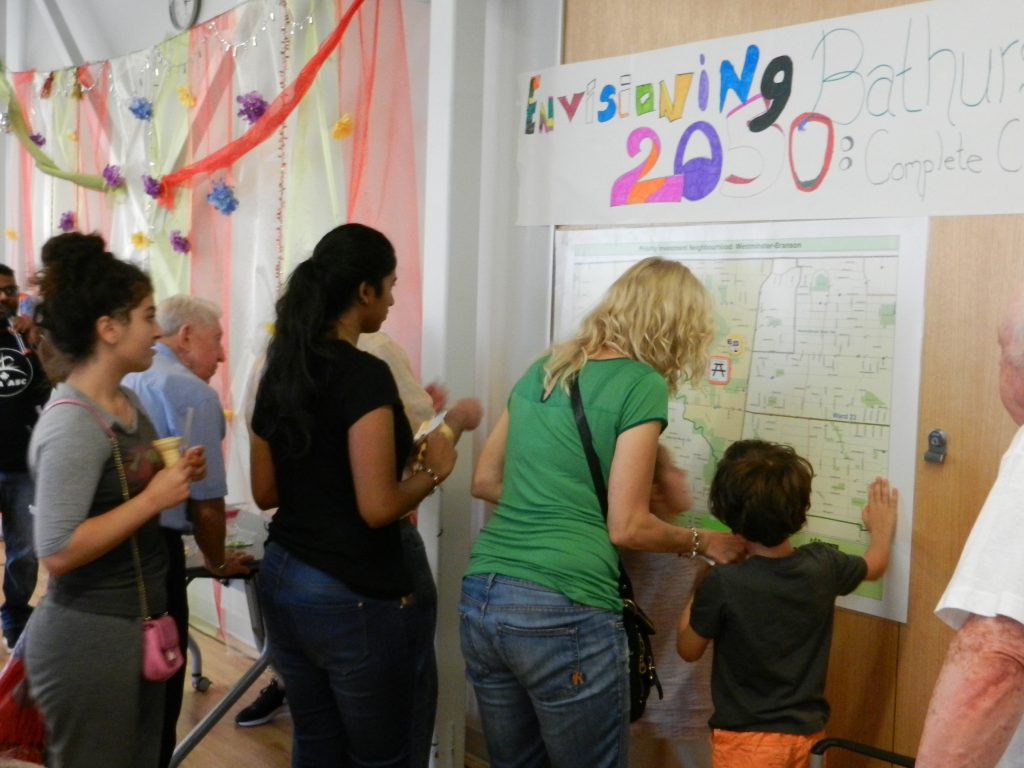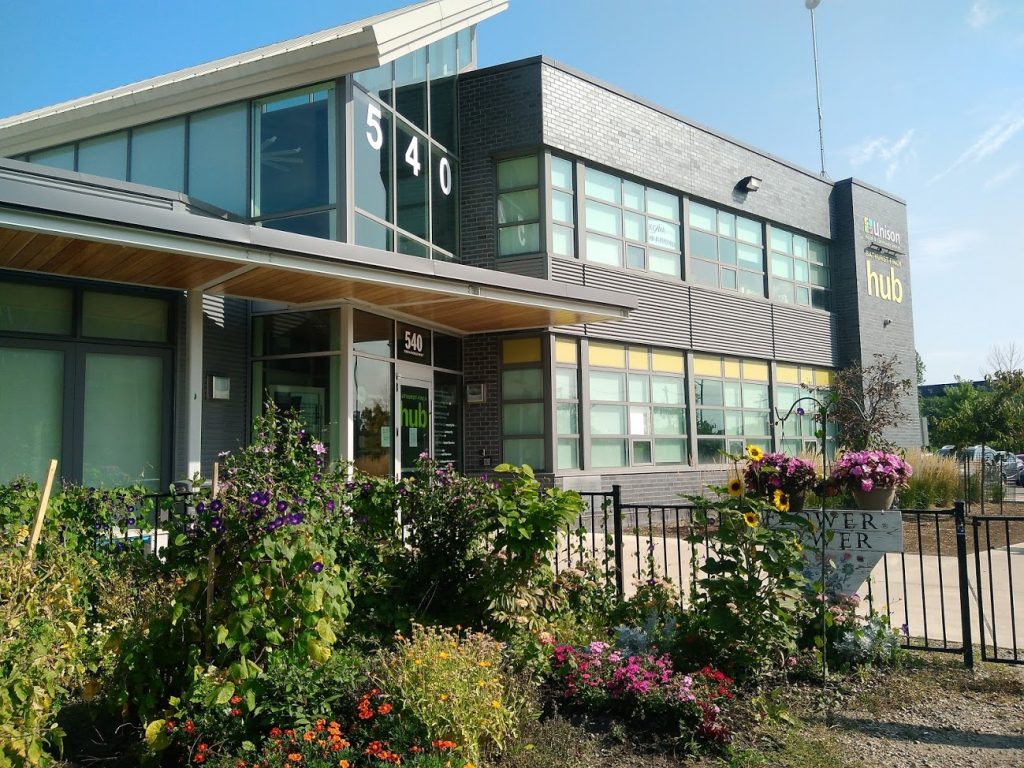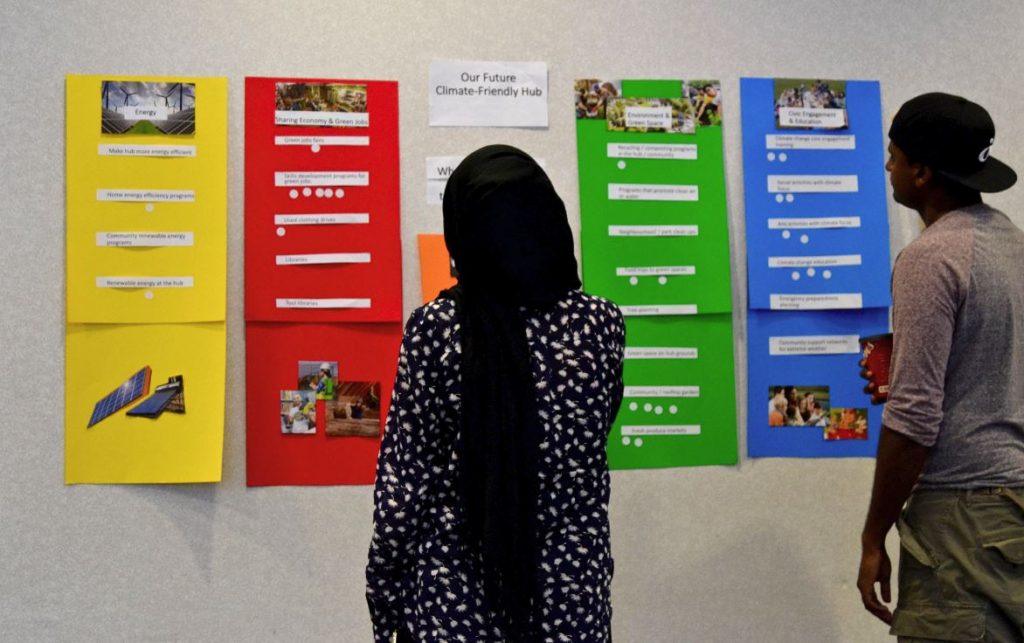Community hubs present a unique opportunity to accelerate local climate action
By Emmay Mah
I am a believer in building a shared vision: to arrive at the future we want, we have to be able to collectively envision it. Two years ago, I was asked by volunteers from the resident-led Bathurst-Finch Social Action Group (SAG) to help plan an activity at a community event. The “Community Fun Day,” hosted by the Action for Neighbourhood Change (ANC) Program at the Bathurst-Finch Unison Hub, featured food, dance and musical performances by local cultural groups. The SAG decided this was a good opportunity to introduce residents from the area to the City’s TransformTO climate action plan, and they led an interactive civic engagement interlude amongst the other festivities.

After a short introduction about the climate plan, the 50-60 residents at the Community Fun Day were asked to build their most ideal community in 2050. The entire room, from young children to seniors, enthusiastically participated. Participants selected foam stickers with visual icons depicting elements from TransformTO and other community priorities – homes, public spaces, jobs, food, accessible streets, services, education, green spaces and renewable energy – and placed them on a large map of the community. Through this exercise, the residents had collectively imagined their “complete community” of the future. This model of engagement, successfully piloted and tested by the Bathurst- Finch ANC program, was a far cry from the formal climate engagement and outreach processes that I had experienced. These processes seldom happened at community spaces or gatherings where people came to have fun and celebrate.
While policymakers and environmental advocates deliberate on how to accelerate our city to net zero emissions, most Torontonians are still unaware of TransformTO, and its relevance to their present and future lives. TransformTO outlines a pathway to achieving Toronto’s emissions reduction goals through executing a bundle of interrelated low-carbon actions. The plan also establishes guiding principles such as advancing social equity, improving public health and affordability, reducing poverty, and creating resilient communities, to ensure that these actions are designed and implemented in a way that maximizes public benefit and minimizes harm. This compels the City of Toronto, and all stakeholders working to achieve a truly equitable, carbon-neutral society, to think deeply about how we bring low-carbon actions to life.
What kind of social and physical infrastructure is needed to generate climate solutions that demonstrate real value to local communities and connect with residents lived experiences?
In 2018, with support from a TAF concept development grant, Enviromentum, a project of Tides Canada, the Toronto Environmental Alliance (TEA), and the Toronto Community Benefits Network launched a feasibility assessment that sought to answer the question: How can hubs serve as launch points for wider community engagement in developing low-carbon communities?
The project concept began with a shared interest in exploring how building “complete communities” could be instrumental in achieving TransformTO’s emission goals, while delivering tangible local benefits. Complete communities are compact, transit-supportive and sustainable, enabling residents to access the services and resources that they need to live and thrive, close to home.
The project team focused on community hubs as a cornerstone of building and animating complete communities.

While the term “community hub” can mean different things to different people, our project interacted largely with physical community centres run by human service agencies. These hubs provide a central access point for a range of health and social services for residents, along with cultural, recreational, and resident leadership programs and community convening space.
We were interested in the hubs’ co-located service model, which is low-carbon by design since it can reduce the distance residents have to travel to access vital services and the operating footprint of individual agencies. We were equally interested in the potential of hubs to promote greater inclusion of Toronto’s diverse communities in locally-relevant climate solutions. Many hubs have been established in under-served neighbourhoods that are home to racialized and newcomer communities and residents with low and moderate incomes. Equity-seeking groups and other residents can be made disproportionately vulnerable to climate change impacts, such as heat waves and floods, by multiple factors such as housing, income, gender, age, health status, access barriers, social marginalization and discrimination. Furthermore, they have seldom benefited from programs that equip residents with resources to prevent and prepare for climate impacts, and have been under-engaged in processes to shape local and city-wide climate strategies.
Over a seven-month period, our project team engaged staff and residents from seven established community hubs, and two hubs in the planning stage, through a variety of consultation methods including: meetings, focus group discussions, an online survey, and an Inter-Hub Climate Forum. The response from hub stakeholders was overwhelmingly positive. They felt that community hubs offer resources such as supportive staff, engaged residents, and physical space, which can be further developed and leveraged to support climate action.

Our feasibility assessment revealed that community hubs have already developed a wide range of initiatives that generate positive outcomes for climate change and the environment, while advancing local priorities.
- Hub grounds and building infrastructure can model sustainable design principles and host inspiring low-carbon projects. There are community hubs that have been built with sustainable features or have developed green infrastructure projects through engaging local residents in community design initiatives. Examples of pro-climate and pro-resilience initiatives include energy efficiency building features, onsite water conservation systems, and green infrastructure such as the East Scarborough Storefront’s Sky-o-SwaleTM.
- Hubs’ locally relevant programs can serve as promising entry points for climate engagement. Community food and garden projects, supported by hubs and led by highly active residents, are already serving as platforms that advance local social equity and environmental goals. Other promising entry points include initiatives that engage residents in waste diversion and active transportation.
- Hubs’ resident leadership and civic engagement initiatives can be a launch point for local participation in climate action. Many hubs run programs to build local leadership capacity to advance neighbourhood priorities. Some hubs have already started to integrate climate change into their resident-led community engagement work, and local initiatives have been seeded to help residents to plan and prepare for extreme weather.
Building on the inspiring initiatives that are already underway, hubs can play a catalytic role in helping residents to envision the transformed, net zero city that we must bring into being.
When we asked hub staff and residents to participate in a future visualization process where “hubs have become the main launch point for supporting residents to develop community solutions to climate change”, they articulated an inspiring vision. They described hubs as transforming community participation in energy, transportation and food systems, green jobs, and the circular economy. They also detailed hubs’ role in sparking ideas, facilitating learning and knowledge sharing, and building the capacity of residents to be climate champions. In many respects, this vision, which is captured in our report, models how TransformTO’s guiding principles can be brought to life in a way that is meaningful to community members.
Over the last two years, with support from Hub staff, the Bathurst-Finch SAG volunteers have continued to work towards making their community vision a reality. They have organized community forums on food security and climate change, and a town hall to give input into the City’s poverty reduction plan. They have developed, and are about to launch, a two-year food project to increase community access to locally-grown produce. The group is keen to introduce renewable energy projects to the neighbourhood, starting with installing a solar array on the Bathurst-Finch Unison Hub’s roof.
Initiatives like these can catalyze bigger solutions. They help us to envision community hubs as spaces where low-carbon projects are incubated and amplified by residents, and also as places of safety with alternative power sources, where residents can gather during extreme weather events. Recently, the Bathurst-Finch Union Hub and TEA have formed a partnership that builds on the findings of the feasibility assessment. With support from TAF, we are launching a phase two project: Accelerating Neighbourhood Climate Solutions Through Community Hubs in collaboration with the Parkdale Activity Recreation Centre and the Centre for Connected Communities. Now that I’ve had a glimpse of what’s possible, I can’t wait to see how local, low-carbon pathways will take shape.
Emmay Mah is the Executive Director of the Toronto Environmental Alliance. Emmay is the Co-Chair of the Toronto Climate Action Network and participated in the City’s Modelling Advisory Group for the TransformTO climate action plan. She is passionate about building a diverse and inclusive climate movement, and a more equitable and sustainable city.
